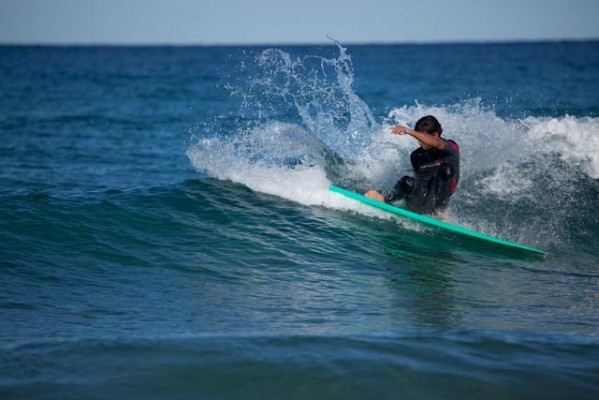
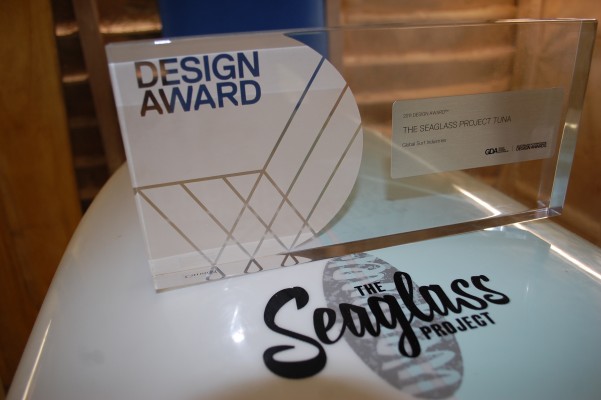 This award is significant. The Australian International Design Awards is recognized as Australia's peak design endorsement scheme and maintains one of the most rigorous product assessment processes in the world. It is the longest standing design awards program and it is thought very highly of in intellectual design circles. The list of judges is extensive and impressive. It shows that an impartial group looked at the Seaglass Tuna and thought, "This is really a significant break through in surfing!" I share this award with Global Surf Industries. We worked together to take the Tuna from the basic sketch of a surfboard to a world wide phenomenon. It is very inspirational and productive to be in team that can put this all together. I am working in my shed and doing R&D (surfing) while the GSI team is putting the boards into production, marketing, distributing and taking care of the business end. In September 2008 I was driving to the surf with my good friend and film maker Nathan Oldfield. We were talking about getting some more footage of the alaia for his upcoming movie and I was saying that the alaia story was pretty much done and that another board was on the way. " The next board will be a big adventure much like the alaia", I said to him. This was the first time that the thought of a new class of surfboard was in formulation. Nathan finished his masterpiece, "Seaworthy", before the Tuna project really started rolling. I had made Tuna number one by that point and the fact that it rode OK gave me the green light to run with it. Things were pretty slow for the first year. The boards worked good in soft, mushy surf but that is rare in Noosa. I spent a lot of time finding that when a good section was forming in front of me I was doomed.
This award is significant. The Australian International Design Awards is recognized as Australia's peak design endorsement scheme and maintains one of the most rigorous product assessment processes in the world. It is the longest standing design awards program and it is thought very highly of in intellectual design circles. The list of judges is extensive and impressive. It shows that an impartial group looked at the Seaglass Tuna and thought, "This is really a significant break through in surfing!" I share this award with Global Surf Industries. We worked together to take the Tuna from the basic sketch of a surfboard to a world wide phenomenon. It is very inspirational and productive to be in team that can put this all together. I am working in my shed and doing R&D (surfing) while the GSI team is putting the boards into production, marketing, distributing and taking care of the business end. In September 2008 I was driving to the surf with my good friend and film maker Nathan Oldfield. We were talking about getting some more footage of the alaia for his upcoming movie and I was saying that the alaia story was pretty much done and that another board was on the way. " The next board will be a big adventure much like the alaia", I said to him. This was the first time that the thought of a new class of surfboard was in formulation. Nathan finished his masterpiece, "Seaworthy", before the Tuna project really started rolling. I had made Tuna number one by that point and the fact that it rode OK gave me the green light to run with it. Things were pretty slow for the first year. The boards worked good in soft, mushy surf but that is rare in Noosa. I spent a lot of time finding that when a good section was forming in front of me I was doomed. 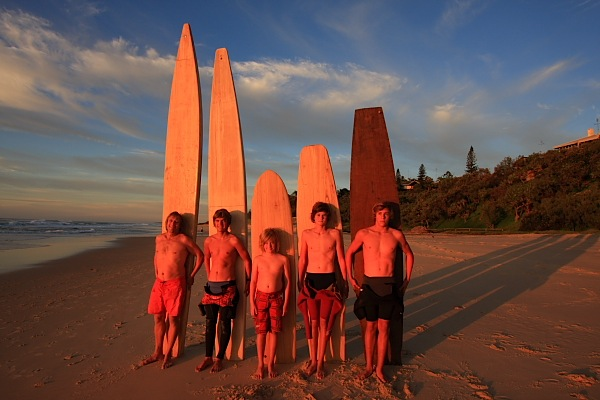
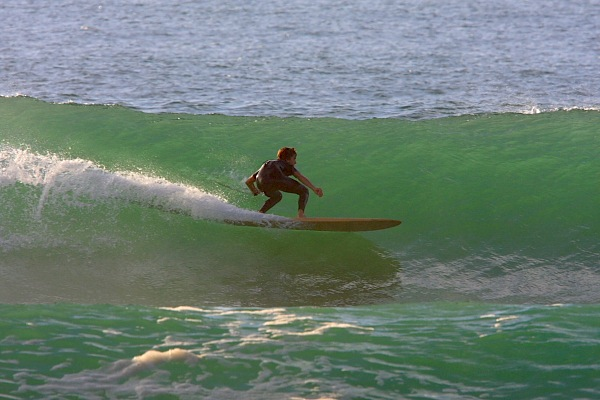 Above: The lineup of test pilots. Me, Jackson Winter, Finley Wegener, Zye Norris and Harrison Biden. Left: Jackson sets an edge in a soft section 2009. Photos Moonwalker There was one very special day when Finley and some awesome young surfers(in the photos) came to the beach and test rode all the Tunas. There was a soft break on the outside and a crunchy shore dump. The bigger Tunas were great on the soft waves while the shorter 7 foot Tuna could ride the outside and the inside. A month later I went to Europe to ride the momentum of alaia popularity. It was GREAT and the enthusiasm for new and unusual boards was peaking. The alaia was very popular, but only a few people could actually surf them. On the other hand, the crowds were out of control and I did not want to surf with so many hundreds of summer surfers riding pointy nosed boards with three sharp fins. It looked dangerous to me. I figured a more floaty alaia would be a better board for the crowds and the conditions. At the same time I was following Cyrus Sutton and Ryan Birch with their basic EPS alaia style Lord Boards. Linking the Lord board to the alaia seemed to be the way into the future. My brother Jon Wegener, was already on to it with the Bluegill project. (A bluegill is a very pleasant North American fish). He was putting small keel fins on foam alaia style boards and they were working great (still are working great) but I wanted to stay with finless boards. To get a board to stick into a wave without fins you need flex. Matt, my apprentice, and Isaac Blyth, an extremely talented Tasmanian surfer, went to work on designing a finless buoyant alaia based board. We used plywood, paulownia, surfboard foam and EPS in an extraordinary amount of combination and configurations to get the flex right. Mark Kelly of GSI had 12 big EPS longboard blanks delivered to the factory which was a giant help and motivation. I had
Above: The lineup of test pilots. Me, Jackson Winter, Finley Wegener, Zye Norris and Harrison Biden. Left: Jackson sets an edge in a soft section 2009. Photos Moonwalker There was one very special day when Finley and some awesome young surfers(in the photos) came to the beach and test rode all the Tunas. There was a soft break on the outside and a crunchy shore dump. The bigger Tunas were great on the soft waves while the shorter 7 foot Tuna could ride the outside and the inside. A month later I went to Europe to ride the momentum of alaia popularity. It was GREAT and the enthusiasm for new and unusual boards was peaking. The alaia was very popular, but only a few people could actually surf them. On the other hand, the crowds were out of control and I did not want to surf with so many hundreds of summer surfers riding pointy nosed boards with three sharp fins. It looked dangerous to me. I figured a more floaty alaia would be a better board for the crowds and the conditions. At the same time I was following Cyrus Sutton and Ryan Birch with their basic EPS alaia style Lord Boards. Linking the Lord board to the alaia seemed to be the way into the future. My brother Jon Wegener, was already on to it with the Bluegill project. (A bluegill is a very pleasant North American fish). He was putting small keel fins on foam alaia style boards and they were working great (still are working great) but I wanted to stay with finless boards. To get a board to stick into a wave without fins you need flex. Matt, my apprentice, and Isaac Blyth, an extremely talented Tasmanian surfer, went to work on designing a finless buoyant alaia based board. We used plywood, paulownia, surfboard foam and EPS in an extraordinary amount of combination and configurations to get the flex right. Mark Kelly of GSI had 12 big EPS longboard blanks delivered to the factory which was a giant help and motivation. I had 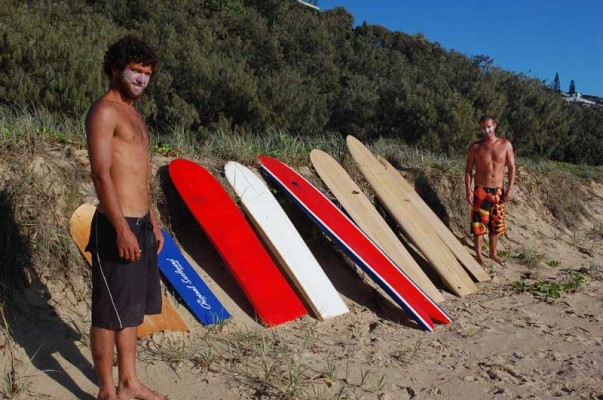 made boards from EPS foam in the 1980s and had a feeling that it had the pop and flex memory that we needed to get a Tuna to hold into the face of a steep wave. This is my favorite shot of Isaac and Eduardo Russel (from France) with a quiver of the boards. We rode all of them that day. The belly boards on the far left are very flexible and with them you feel how important flex is and how necessary the feeling is on a wave. We worked from November 2009 to March 2010 on prototype after prototype. Progress was slow and I was actually having a hard time riding the boards. The young guys were good, but for a board to go main stream I have to be able to enjoy it immensely. On my 45th birthday, March 5 2010, I pulled a sweet bottom turn and came off the lip on an EPS Tuna and I felt we were on the right track.
made boards from EPS foam in the 1980s and had a feeling that it had the pop and flex memory that we needed to get a Tuna to hold into the face of a steep wave. This is my favorite shot of Isaac and Eduardo Russel (from France) with a quiver of the boards. We rode all of them that day. The belly boards on the far left are very flexible and with them you feel how important flex is and how necessary the feeling is on a wave. We worked from November 2009 to March 2010 on prototype after prototype. Progress was slow and I was actually having a hard time riding the boards. The young guys were good, but for a board to go main stream I have to be able to enjoy it immensely. On my 45th birthday, March 5 2010, I pulled a sweet bottom turn and came off the lip on an EPS Tuna and I felt we were on the right track. 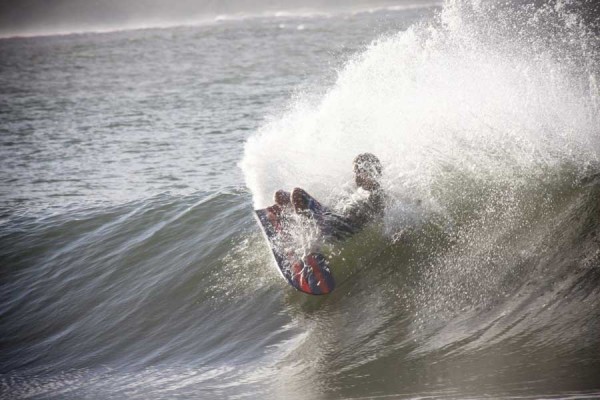 Then Isaac pulled this enormous cutback in the middle of the finless expression session at the Noosa Festival of Surfing. We were all speechless. So, yes they were working. After 27 different shapes, I set to shaping the final master copies for GSI. It took days to shape them knowing that these were the molds for the boards and the type of surfing that was to follow. Even after the copies of the boards came back from GSI, there was still a lot of testing and fine tuning of the shapes, in conjunction with the big board manufacturer, to get the whole system working.
Then Isaac pulled this enormous cutback in the middle of the finless expression session at the Noosa Festival of Surfing. We were all speechless. So, yes they were working. After 27 different shapes, I set to shaping the final master copies for GSI. It took days to shape them knowing that these were the molds for the boards and the type of surfing that was to follow. Even after the copies of the boards came back from GSI, there was still a lot of testing and fine tuning of the shapes, in conjunction with the big board manufacturer, to get the whole system working. 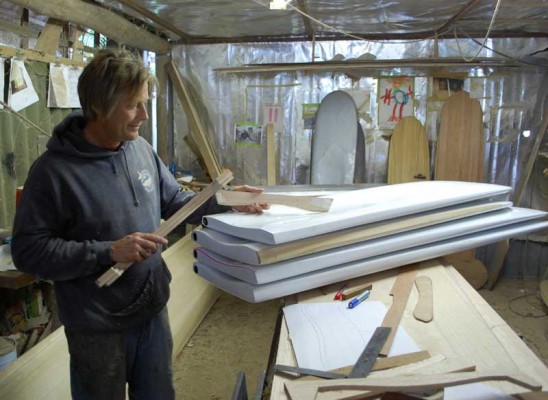 In September 2010, Global Surf Industries launched The Seaglass Project and threw the doors open to the world. Many surf shops jumped on board seeing this as an exciting and sunny moment in a dark world economy. Aside from the tuned in surfers familiar with ancient Hawaiian surfing from the alaia, the public was a little slow to put their dollars down on an extremely unusual design. To put things into perspective, six years ago, riding a finless surfboard was essentially unheard of. When I started reproducing thin wood alaias based on ancient Hawaiian design, most people did not even see a "surfboard". Taking the fins off a surfboard was like telling you to go out and jack your car up, take the wheels off, lower it to the ground and it will drive better! The 2011 Australian International Design Award will help the public see that this is not only a great design but a practical surfboard. For me, I can ride any surfboard in the world. I can make any board in my factory and the Seaglass Tuna is what I surf most often. I see the young kids ripping on them and carving the wave in ways inconceivable on a finned board. A great surfer, Ozzy Wright just tried a tuna for the first time the other day. Please check out this video.. It is amazing how quickly he picked it up!!! He is such a good surfer. I would love to see him after a few more sessions. Ozzy on a tuna
In September 2010, Global Surf Industries launched The Seaglass Project and threw the doors open to the world. Many surf shops jumped on board seeing this as an exciting and sunny moment in a dark world economy. Aside from the tuned in surfers familiar with ancient Hawaiian surfing from the alaia, the public was a little slow to put their dollars down on an extremely unusual design. To put things into perspective, six years ago, riding a finless surfboard was essentially unheard of. When I started reproducing thin wood alaias based on ancient Hawaiian design, most people did not even see a "surfboard". Taking the fins off a surfboard was like telling you to go out and jack your car up, take the wheels off, lower it to the ground and it will drive better! The 2011 Australian International Design Award will help the public see that this is not only a great design but a practical surfboard. For me, I can ride any surfboard in the world. I can make any board in my factory and the Seaglass Tuna is what I surf most often. I see the young kids ripping on them and carving the wave in ways inconceivable on a finned board. A great surfer, Ozzy Wright just tried a tuna for the first time the other day. Please check out this video.. It is amazing how quickly he picked it up!!! He is such a good surfer. I would love to see him after a few more sessions. Ozzy on a tuna
For a video history of the Seaglass Project please see the blog entry to the right. 